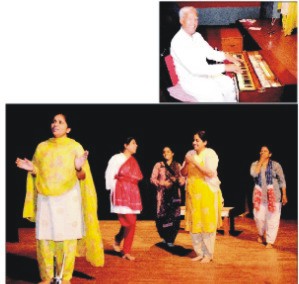Y. M. Puttannaiah might be a new name for majority of Mysoreans but not for theatre buffs. He is one among the best Harmonium Masters who has kept the old tradition alive even today.
This year’s Bahuroopi theatre festival will feature ‘Sadarama Natakam,’ a play which is being directed by Puttannaiah for the Rangayana artistes.
The play was staged a couple of years back by the artistes during the weekend shows, but was later stopped. Now, it is making a comeback through Bahuroopi.
‘Sadarama Natakam,’ a play which was written by Bellave Narasimha Shastry, was staged by Gubbi Veeranna Company and many other company theatre companies of the yesteryears. The play which used to begin in the night would continue till early morning.
For Rangayana artistes to stage the play, there was a necessity of a person like Puttannaiah, who had the experience of working in Gubbi Company and also teaching theatre songs to the artistes.
Puttannaiah has been presented with many awards among which the prestigious ‘Karnataka Nataka Academy’ (2009) stands tall.
The original script of ‘Sadarama Natakam’ has 108 songs and was staged for over 6 hours, but it has now been reduced to 3 hours and 17 important songs have been retained in the play.
Speaking to Star of Mysore, Puttannaiah shared his theatre journey which he enjoyed for 50 years. Excerpts.
By S.N. Venkatnag Sobers
Star of Mysore (SOM): What attracted you to enter theatre?
Y.M. Puttannaiah: I used to watch my father Rajapart Muddurangappa enacting plays while he was working for Gubbi Company. Since I spent most of my childhood in the Gubbi Company, I had no other option but to enter theatre.
SOM: Which was your first play and when did you learn music?
Puttannaiah: My first play was Mahasathi Anasuya in the year 1962. It was a small role but since then my journey in theatre began and I acted in a lot of plays among which I played the roles of Prahlada and young Krishna in my teens. Later, it was the music which fascinated me; I learnt classical music and also to play instruments. I have worked as a music teacher in many of theatre companies such as Uma Maheshwari Company, Hirannaiah Mitra Mandali etc. It was in 1971 that I started a music institute in Huliyar when the theatre companies closed down.
SOM: Take us on your journey. When did you come to Mysore?
Puttannaiah: After my stint with the music institute, my family decided to shift to Mysore to provide quality education for the children in the year 1978. I was not involved in any theatre activities, but Yoganarasimha Murthy and actor Sundarakrishna Urs got to know I was in Mysore and forced me to work with them for a play called Adige Bhatta. Since then I have been involved in theatre activities in Mysore. I should also thank amateur groups in Mysore such as Amarakala Sangha, Nadaranga, Suruchi Rangamane, Kadamba Ranga Vedike and others for giving me an opportunity to work with them.
SOM: Share with us your experience with Rangayana.
Puttannaiah: Well, what can be said about Rangayana? The theatre repertory which was started by B.V. Karanth has grown up to become one of the best theatre schools in the country. I got involved with Rangayana when they approached me for Sadarama Natakam a couple of years back. Since then I have been visiting this place when ever my services are needed.
SOM: Having worked with amateurs for most of your career, how do you rate Ranga-yana artistes?
Puttannaiah: There is no doubt that the artistes in Rangayana are among the best actors. After being trained under B.V. Karanth, there is nothing that I could teach them. Being professional artistes, they adapted to the change that was required to stage Sadarama Natakam which is enacted in old company style.
When the play was staged for the first time a couple of years back, it was even the first time that these actors sang on stage. Till then, they used to sing from behind the screens. Since this play needs the actors to sing on stage, they executed it well.
SOM: Tell us about Sada-rama Natakam. What is its relevance to the present day scenario?
Puttannaiah: The play has relevance to the present day as it talks about a girl’s fight against injustice during the King’s rule. Today, the same situation is prevailing in the city; except that the rule of the princely state has gone.
SOM: What do you have to say about the present day theatre?
Puttannaiah: Theatre, an ancient art, is definitely seeing a downfall. It is the responsibility of the concerned authorities to chalk out programmes to promote and retain the art for the generations to come.
source: http://www.StarofMysore.com / Home> Feature Articles / by S.N. Venkatnag Sobers / January 07th, 2013
